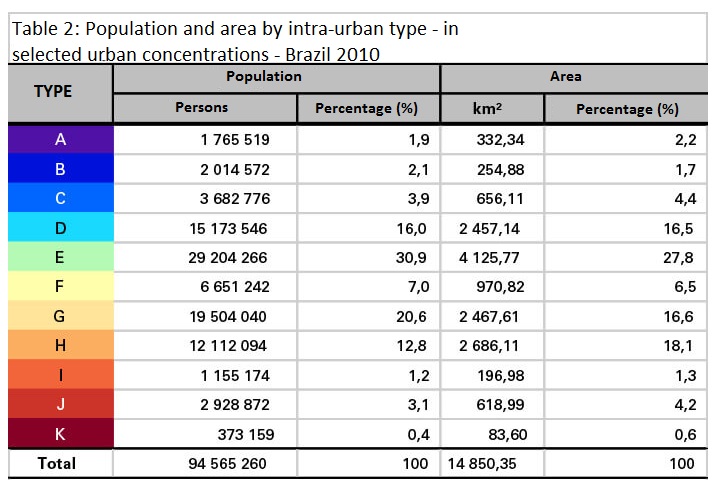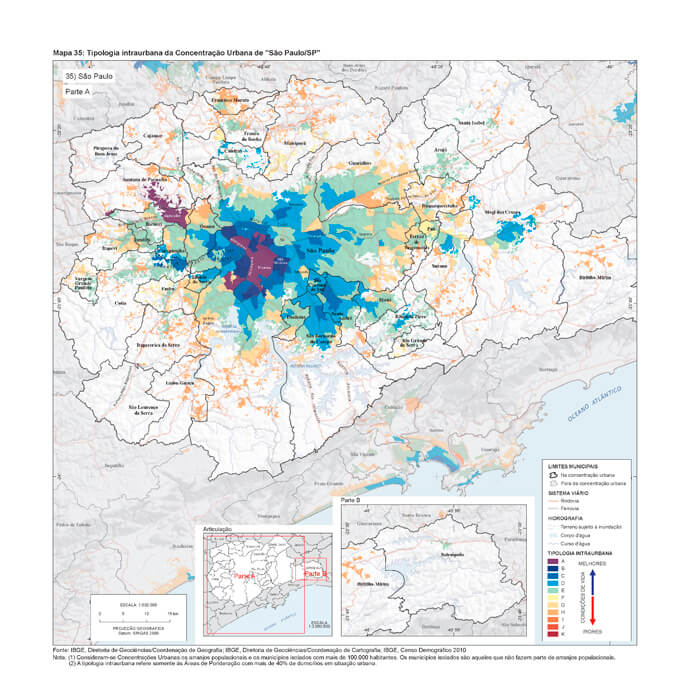In urban concentrations of Brazil, 61.9% of the residents lived in areas with good or average living conditions
December 20, 2017 10h00 AM | Last Updated: December 20, 2017 05h14 PM
In 2010, the biggest part of the population in urban concentrations lived in locations with good and average conditions. That means 58.5 million persons (or 61.9%) of the total 94.6 million living in urban areas, as shown by the spatial analysis of different socioeconomic aspects revealed in the 2010 Population Census, and now presented in the publication Intra-urban Typology – Spaces of socioeconomic differentiation in urban concentrations in Brazil. The analysis combines information about sanitation, density of residents per housing unit, income, level of schooling, dependency ratio (ration between youth and elderly population), type of coating applied to home walls and the existence of certain durable goods, leading to a classification of 11 different levels that range between good and precarious living conditions.
The South Region had the biggest percentages (72.2%) of the urban population living in good and average conditions.
The publication presents a group of cartograms and analytical texts, being also available on a digital platform, by means of interactive maps.
Intra-urban Typology classifies living conditions into 11 types (from A – the best – to K – precarious) for each one of the 65 urban concentrations with a population of more than 300 thousand residents. A total 435 municipalities have been analyzed, inhabited by half of the population (94,6 million persons) in the country in 2010. Each urban concentration is usually formed by more than one municipality.

The 11 levels of living conditions having been set according to the following characteristics: access to water supply, to sewage disposal and garbage collection services; average number of residents per room used as a bedroom; per capita household income; level of schooling; dependency ratio of residents under 15 years of age; type of construction material and coating used on the outside walls of the housing unit; and existence of a washing machine and a computer with Internet access.
Living conditions vary in Brazilian urban concentrations
The table below shows the amount and percentage of the population living in each of the 11 living conditions, and the area taken up by each one of them. Most of the population (61.9% or 58.5 million persons) were in areas with good and average living conditions (types A to F).

The South had the biggest part of the population (72.2%) living in good and average conditions (A to F). Regarding the richest types (A and B), the Central West had the biggest population (7.1% or 507 thousand persons). In absolute figures, the Southeast had the biggest number of persons living in rich areas (2.3 million or 4.6%).
The biggest proportion of the population in urban areas living in the worst conditions (categories G to K) were found in the Northeast (59.9%), followed by the North (56.3%), a Major Region that had the biggest proportion of persons in housing units with very low or precarious living conditions (35.4%).
The North and Northeast followed their own patterns. The former had a big percentage of its population concentrates in type F (37.0%), followed by type (25.6%). The latter, on the other hand, gathered the biggest proportion of persons under type (34.1%), followed by types H and F, with 18.2% and 17.7%, respectively.

Among the major urban concentrations is Brasília, with most of its population living in rich areas (13.1% in types A or B or 425,801 persons). The capital of Brazil also held the biggest rich territory (199.7 Km² or 30% of its urban area) among urban concentrations in the country, mainly represented by Plano Piloto. In spite of having a smaller percentage of persons in rich areas, São Paulo (5.1%) had the biggest number of persons living in those areas (982,927 persons), concentrated in the area known Centro Expandido (Downtown Extension). In Rio de Janeiro, rich areas gathered 878,320 persons (7.3%) and were mainly located in coastal areas.

Regarding the biggest urban concentrations, Belém (28.5% or 570,439 persons) and Manaus (28,.3% or 508.352) concentrated the biggest percentage of the population in areas with very bad or precarious living conditions (types I, J and K). Also considering the 15 biggest urban concentrations, all of them, except Belém, Fortaleza and had more than half of the population living in areas with good or average conditions (Types A to F). The publication has 65 maps of urban concentrations in the country, with more 12 detailed maps of the main Brazilian metropolises. See below for example, the map of São Paulo.


